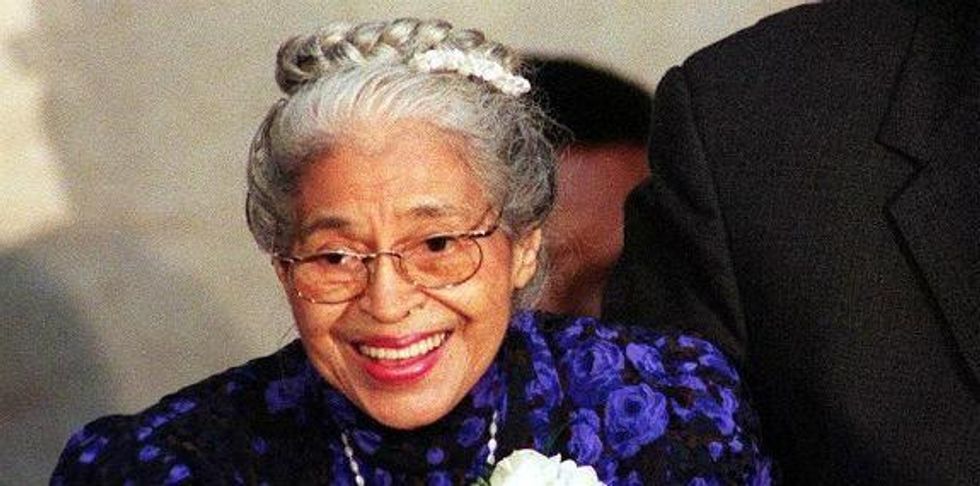Rosa Parks' Stamp on American History
As we honor the centennial of her birth, let's understand the full measure of her legacy

Yet these tributes to Rosa Parks rest on a narrow and distorted vision of her legacy. As the story goes, a quiet Montgomery, Ala., seamstress with a single act challenged Southern segregation, catapulted a young Martin Luther King Jr. into national leadership and ushered in the modern civil rights movement. Parks' memorialization promotes an improbable children's story of social change -- one not-angry woman sat down, the country was galvanized and structural racism was vanquished.
This fable diminishes the extensive history of collective action against racial injustice and underestimates the widespread opposition to the black freedom movement, which for decades treated Parks' political activities as "un-American." Most important, it skips over the enduring scourge of racial inequality in American society -- a reality that Parks continued to highlight and challenge -- and serves contemporary political interests that treat racial injustice as a thing of the past.
A more thorough accounting of Parks' political life offers a different set of reasons for the nation to honor her. Laboring in the 1940s and 1950s in relative obscurity, Parks and her colleague E.D. Nixon were among a small group who sought to transform Montgomery's NAACP into a more activist branch, determined to register their dissent, even if they could deal no significant blow to white supremacy. With Nixon as branch president and Parks as secretary, they pushed for black-voter registration, legal justice and school desegregation -- and Parks traveled the state documenting white brutality and legal malfeasance. The summer before her bus stand, she attended a two-week workshop at Highlander Folk School, an interracial, adult organizer training school in Tennessee, to organize for the implementation of school desegregation.
Knowing well the cost of bus resistance (a neighbor had been killed for his resistance, the young Claudette Colvin manhandled) and having made numerous personal stands against segregation that went nowhere, Parks understood the cost, danger and likely ineffectiveness of her stand. And yet "pushed as far as [she] could stand to be pushed," she did it anyway. When, to her surprise, her arrest galvanized a mass movement, she worked hard to sustain it over the next year.
Her stand led to significant economic and personal hardship for her family. In the early days of the boycott, both Rosa and Raymond Parks lost their jobs. Eight months after the boycott ended, still unable to find work, in poor health and continuing to face death threats, they left Montgomery for Detroit. There she did not rest, but joined with new and old comrades to fight the racism of her new hometown and American society more broadly.
One of the greatest distortions of the Parks fable is the way it portrays her as meek, missing the resolute political sensibility that identified Malcolm X as her personal hero. Arriving in Detroit in 1957, she spent more than half her life fighting racial injustice in the Jim Crow North. Describing the city as the "promised land that wasn't," the Parks family lived in the "heart of the ghetto" and found racism in Detroit "almost as widespread as Montgomery." Having volunteered on his upstart political campaign, Parks was hired by the newly elected Rep. John Conyers in 1965 to be part of his Detroit staff, where she worked on issues such as police brutality, open housing, welfare and job discrimination -- the plagues of Northern racism.
Her long-standing political commitments to self-defense, black history, economic justice, police accountability and black political empowerment intersected with key aspects of the Black Power movement, and she took part in numerous mobilizations in the late 1960s and 1970s. An internationalist, she opposed U.S. involvement in Vietnam, demonstrated at the South African embassy to condemn apartheid and contested U.S. policy in Central America. Eight days after 9/11, she joined other activists in a letter calling for justice, not vengeance, insisting the U.S. must work with the international community and warning against retaliation or war.
To the end of her life, Parks continued to stress the enduring need for social change, reminding Americans "not [to] become comfortable with the gains we have made in the last forty years." That lifetime of steadfastness and outrage, tenacity and bravery, is what deserves national veneration.
Doing justice to Parks' actual legacy thus requires something of us -- something much harder than a stamp or a statue. Rosa Parks' courage was the ability to make an independent stand, even though she and others had done it before and nothing had changed, and even when she well-understood the harm that might befall her. She made those stands over and over throughout the course of her life.
Honoring her legacy means summoning similar audacity. It requires acknowledging that America is not a postracial society and that the blight of racial and social injustice is deep and manifest. It entails a profound recommitment to the goals for which she spent a lifetime fighting -- a criminal justice system fair and just to people of color, unfettered voting rights, educational access and equity, real assistance to the poor, an end to U.S. wars of occupation and black history in all parts of school curricula. Finally, it means heeding her words to Spelman College students: "Don't give up, and don't say the movement is dead."
An Urgent Message From Our Co-Founder
Dear Common Dreams reader, The U.S. is on a fast track to authoritarianism like nothing I've ever seen. Meanwhile, corporate news outlets are utterly capitulating to Trump, twisting their coverage to avoid drawing his ire while lining up to stuff cash in his pockets. That's why I believe that Common Dreams is doing the best and most consequential reporting that we've ever done. Our small but mighty team is a progressive reporting powerhouse, covering the news every day that the corporate media never will. Our mission has always been simple: To inform. To inspire. And to ignite change for the common good. Now here's the key piece that I want all our readers to understand: None of this would be possible without your financial support. That's not just some fundraising cliche. It's the absolute and literal truth. We don't accept corporate advertising and never will. We don't have a paywall because we don't think people should be blocked from critical news based on their ability to pay. Everything we do is funded by the donations of readers like you. Will you donate now to help power the nonprofit, independent reporting of Common Dreams? Thank you for being a vital member of our community. Together, we can keep independent journalism alive when it’s needed most. - Craig Brown, Co-founder |

Yet these tributes to Rosa Parks rest on a narrow and distorted vision of her legacy. As the story goes, a quiet Montgomery, Ala., seamstress with a single act challenged Southern segregation, catapulted a young Martin Luther King Jr. into national leadership and ushered in the modern civil rights movement. Parks' memorialization promotes an improbable children's story of social change -- one not-angry woman sat down, the country was galvanized and structural racism was vanquished.
This fable diminishes the extensive history of collective action against racial injustice and underestimates the widespread opposition to the black freedom movement, which for decades treated Parks' political activities as "un-American." Most important, it skips over the enduring scourge of racial inequality in American society -- a reality that Parks continued to highlight and challenge -- and serves contemporary political interests that treat racial injustice as a thing of the past.
A more thorough accounting of Parks' political life offers a different set of reasons for the nation to honor her. Laboring in the 1940s and 1950s in relative obscurity, Parks and her colleague E.D. Nixon were among a small group who sought to transform Montgomery's NAACP into a more activist branch, determined to register their dissent, even if they could deal no significant blow to white supremacy. With Nixon as branch president and Parks as secretary, they pushed for black-voter registration, legal justice and school desegregation -- and Parks traveled the state documenting white brutality and legal malfeasance. The summer before her bus stand, she attended a two-week workshop at Highlander Folk School, an interracial, adult organizer training school in Tennessee, to organize for the implementation of school desegregation.
Knowing well the cost of bus resistance (a neighbor had been killed for his resistance, the young Claudette Colvin manhandled) and having made numerous personal stands against segregation that went nowhere, Parks understood the cost, danger and likely ineffectiveness of her stand. And yet "pushed as far as [she] could stand to be pushed," she did it anyway. When, to her surprise, her arrest galvanized a mass movement, she worked hard to sustain it over the next year.
Her stand led to significant economic and personal hardship for her family. In the early days of the boycott, both Rosa and Raymond Parks lost their jobs. Eight months after the boycott ended, still unable to find work, in poor health and continuing to face death threats, they left Montgomery for Detroit. There she did not rest, but joined with new and old comrades to fight the racism of her new hometown and American society more broadly.
One of the greatest distortions of the Parks fable is the way it portrays her as meek, missing the resolute political sensibility that identified Malcolm X as her personal hero. Arriving in Detroit in 1957, she spent more than half her life fighting racial injustice in the Jim Crow North. Describing the city as the "promised land that wasn't," the Parks family lived in the "heart of the ghetto" and found racism in Detroit "almost as widespread as Montgomery." Having volunteered on his upstart political campaign, Parks was hired by the newly elected Rep. John Conyers in 1965 to be part of his Detroit staff, where she worked on issues such as police brutality, open housing, welfare and job discrimination -- the plagues of Northern racism.
Her long-standing political commitments to self-defense, black history, economic justice, police accountability and black political empowerment intersected with key aspects of the Black Power movement, and she took part in numerous mobilizations in the late 1960s and 1970s. An internationalist, she opposed U.S. involvement in Vietnam, demonstrated at the South African embassy to condemn apartheid and contested U.S. policy in Central America. Eight days after 9/11, she joined other activists in a letter calling for justice, not vengeance, insisting the U.S. must work with the international community and warning against retaliation or war.
To the end of her life, Parks continued to stress the enduring need for social change, reminding Americans "not [to] become comfortable with the gains we have made in the last forty years." That lifetime of steadfastness and outrage, tenacity and bravery, is what deserves national veneration.
Doing justice to Parks' actual legacy thus requires something of us -- something much harder than a stamp or a statue. Rosa Parks' courage was the ability to make an independent stand, even though she and others had done it before and nothing had changed, and even when she well-understood the harm that might befall her. She made those stands over and over throughout the course of her life.
Honoring her legacy means summoning similar audacity. It requires acknowledging that America is not a postracial society and that the blight of racial and social injustice is deep and manifest. It entails a profound recommitment to the goals for which she spent a lifetime fighting -- a criminal justice system fair and just to people of color, unfettered voting rights, educational access and equity, real assistance to the poor, an end to U.S. wars of occupation and black history in all parts of school curricula. Finally, it means heeding her words to Spelman College students: "Don't give up, and don't say the movement is dead."

Yet these tributes to Rosa Parks rest on a narrow and distorted vision of her legacy. As the story goes, a quiet Montgomery, Ala., seamstress with a single act challenged Southern segregation, catapulted a young Martin Luther King Jr. into national leadership and ushered in the modern civil rights movement. Parks' memorialization promotes an improbable children's story of social change -- one not-angry woman sat down, the country was galvanized and structural racism was vanquished.
This fable diminishes the extensive history of collective action against racial injustice and underestimates the widespread opposition to the black freedom movement, which for decades treated Parks' political activities as "un-American." Most important, it skips over the enduring scourge of racial inequality in American society -- a reality that Parks continued to highlight and challenge -- and serves contemporary political interests that treat racial injustice as a thing of the past.
A more thorough accounting of Parks' political life offers a different set of reasons for the nation to honor her. Laboring in the 1940s and 1950s in relative obscurity, Parks and her colleague E.D. Nixon were among a small group who sought to transform Montgomery's NAACP into a more activist branch, determined to register their dissent, even if they could deal no significant blow to white supremacy. With Nixon as branch president and Parks as secretary, they pushed for black-voter registration, legal justice and school desegregation -- and Parks traveled the state documenting white brutality and legal malfeasance. The summer before her bus stand, she attended a two-week workshop at Highlander Folk School, an interracial, adult organizer training school in Tennessee, to organize for the implementation of school desegregation.
Knowing well the cost of bus resistance (a neighbor had been killed for his resistance, the young Claudette Colvin manhandled) and having made numerous personal stands against segregation that went nowhere, Parks understood the cost, danger and likely ineffectiveness of her stand. And yet "pushed as far as [she] could stand to be pushed," she did it anyway. When, to her surprise, her arrest galvanized a mass movement, she worked hard to sustain it over the next year.
Her stand led to significant economic and personal hardship for her family. In the early days of the boycott, both Rosa and Raymond Parks lost their jobs. Eight months after the boycott ended, still unable to find work, in poor health and continuing to face death threats, they left Montgomery for Detroit. There she did not rest, but joined with new and old comrades to fight the racism of her new hometown and American society more broadly.
One of the greatest distortions of the Parks fable is the way it portrays her as meek, missing the resolute political sensibility that identified Malcolm X as her personal hero. Arriving in Detroit in 1957, she spent more than half her life fighting racial injustice in the Jim Crow North. Describing the city as the "promised land that wasn't," the Parks family lived in the "heart of the ghetto" and found racism in Detroit "almost as widespread as Montgomery." Having volunteered on his upstart political campaign, Parks was hired by the newly elected Rep. John Conyers in 1965 to be part of his Detroit staff, where she worked on issues such as police brutality, open housing, welfare and job discrimination -- the plagues of Northern racism.
Her long-standing political commitments to self-defense, black history, economic justice, police accountability and black political empowerment intersected with key aspects of the Black Power movement, and she took part in numerous mobilizations in the late 1960s and 1970s. An internationalist, she opposed U.S. involvement in Vietnam, demonstrated at the South African embassy to condemn apartheid and contested U.S. policy in Central America. Eight days after 9/11, she joined other activists in a letter calling for justice, not vengeance, insisting the U.S. must work with the international community and warning against retaliation or war.
To the end of her life, Parks continued to stress the enduring need for social change, reminding Americans "not [to] become comfortable with the gains we have made in the last forty years." That lifetime of steadfastness and outrage, tenacity and bravery, is what deserves national veneration.
Doing justice to Parks' actual legacy thus requires something of us -- something much harder than a stamp or a statue. Rosa Parks' courage was the ability to make an independent stand, even though she and others had done it before and nothing had changed, and even when she well-understood the harm that might befall her. She made those stands over and over throughout the course of her life.
Honoring her legacy means summoning similar audacity. It requires acknowledging that America is not a postracial society and that the blight of racial and social injustice is deep and manifest. It entails a profound recommitment to the goals for which she spent a lifetime fighting -- a criminal justice system fair and just to people of color, unfettered voting rights, educational access and equity, real assistance to the poor, an end to U.S. wars of occupation and black history in all parts of school curricula. Finally, it means heeding her words to Spelman College students: "Don't give up, and don't say the movement is dead."

